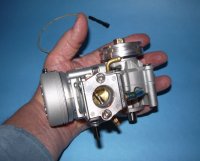Twin rudder VS Single
tatman created the topic: Twin rudder VS Single
Well I did my build MY Way. Some parts better than others. My problem is in turns to the left I bury the bow. Usually accelerating and maybe not on plane. This is an inboard rig with the rudder quite close to the prop. I like that there is minimum rooster tail from the inboard setup. I don't like how the prop walks. Do you think twin rudders will solve my sinking problem and help with "prop walk?" I'm not building a racer here just something fast and not so prone to sinking. Thanks
Please Log in or Create an account to join the conversation.
- tatman
- Offline
- Posts: 5
- Thank you received: 0
Hot Rods replied the topic: Twin rudder VS Single
There are a number of contributors to your handling troubles.
Due to the counter-clockwise ( as viewed from the transom ) rotation of the prop, model boats don't turn as well, or as easily to the left, as they do to the right. You have a "high lift", surfacing prop on it, that tries to surface the transom. That in turn drops the bow. Rudder vertical angle has an effect on turning as well as straight line running. If the bow is dropping, angle ( if the mount allows ) the bottom of the rudder "in" ( negative ) toward the transom slightly. Make sure your trim tabs are not pushing the bow down in the turns. Check that your center of gravity ( fore and aft ) isn't too far forward. If it's anything higher than about 30%, you may do better moving some weight back. Whatever prop you use must be thin and very sharp. Smaller props on submerged drives will free up the motor and cause less walk. Double rudders may help a little, but a single deep rudder offset to starboard 2 1/2", and well behind the prop, can as well, without adding extra drag. An offset rudder runs in "clean" water, and can help handling and turning better than one that is operating in aerated/turbulent water. Make sure the running surface is even side to side. Either flat or the same amount hook on both sides.
Many guys like to build their models more "realistic" and to look nice. And while that's fine for a shelf model, a lot of them complain about the way they behave. They don't want a race boat, but they want them to handle really well. The thing is, that the boats are scaled down, but the physics of power and torque, and the WATER, is full scale. So some of the ways race model boats are rigged, has just as much to do with good handling as it does speed. Like most things in life, we have to compromise for the desired results.
Due to the counter-clockwise ( as viewed from the transom ) rotation of the prop, model boats don't turn as well, or as easily to the left, as they do to the right. You have a "high lift", surfacing prop on it, that tries to surface the transom. That in turn drops the bow. Rudder vertical angle has an effect on turning as well as straight line running. If the bow is dropping, angle ( if the mount allows ) the bottom of the rudder "in" ( negative ) toward the transom slightly. Make sure your trim tabs are not pushing the bow down in the turns. Check that your center of gravity ( fore and aft ) isn't too far forward. If it's anything higher than about 30%, you may do better moving some weight back. Whatever prop you use must be thin and very sharp. Smaller props on submerged drives will free up the motor and cause less walk. Double rudders may help a little, but a single deep rudder offset to starboard 2 1/2", and well behind the prop, can as well, without adding extra drag. An offset rudder runs in "clean" water, and can help handling and turning better than one that is operating in aerated/turbulent water. Make sure the running surface is even side to side. Either flat or the same amount hook on both sides.
Many guys like to build their models more "realistic" and to look nice. And while that's fine for a shelf model, a lot of them complain about the way they behave. They don't want a race boat, but they want them to handle really well. The thing is, that the boats are scaled down, but the physics of power and torque, and the WATER, is full scale. So some of the ways race model boats are rigged, has just as much to do with good handling as it does speed. Like most things in life, we have to compromise for the desired results.
Last edit: 11 years 11 months ago by Hot Rods.
Please Log in or Create an account to join the conversation.
- Hot Rods
-

- Offline
- Posts: 164
- Karma: -5
- Thank you received: 36
Time to create page: 0.081 seconds
